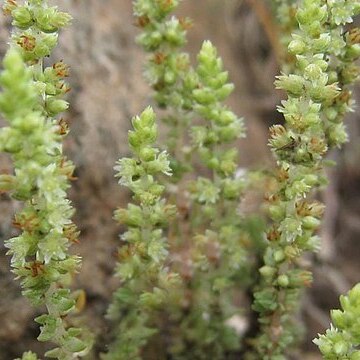Perennial herb, succulent, several rosettes, leaf pairs spirally arranged, old ones remaining on stem, 0.1-0.2 m high when flowering, thick tuberous root. Leaves oblanceolate-oblong, 20-40 x 5-15 mm, acute, dorsiventrally flattened but convex, glabrous or with few cilia, green tinged red. Inflorescence a spike-like thyrse, sessile flowers; peduncle distinct with leaf-like bracts shorter than leaves. Calyx fleshy, acute tapering into terminal hair, glabrous with marginal cilia, green. Corolla tubular, fused 1 mm, white; lobes oblong-ovate, 4-5 mm long, acute, recurved. Flowering time Nov.-Jan.
Often tuberous-rooted perennial, with several leaf-rosettes, up to 0.2 m tall when flowering. Leaves sessile, oblanceolate-oblong, dorsiventrally compressed, 20-40 x 5-15 mm, glabrous, with a few marginal cilia. Flowers nearly sessile, in several, ± loose clusters, in a spike-like inflorescence on a distinct, leafy bracteate, glabrous peduncle, tubular, petals 4-5 mm long, fused in lower 1 mm, white.
Tufted perennial to 20 cm, with brittle branches. Leaves oblanceolate-oblong, often red on margins. Flowers in pedunculate, spike-like clusters, tubular, subsessile, white, petals ± 4.5 mm long.


